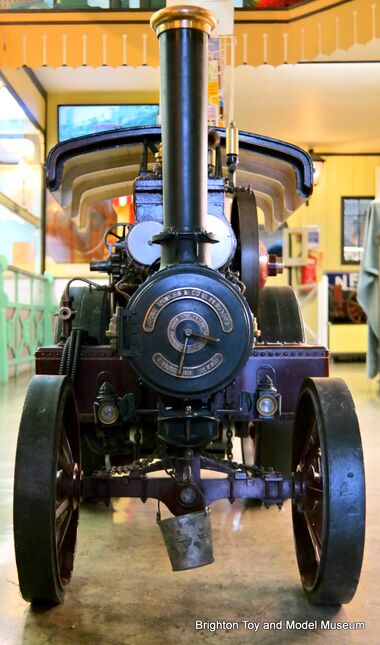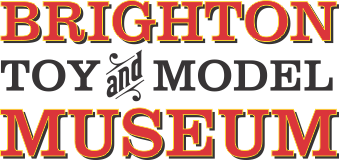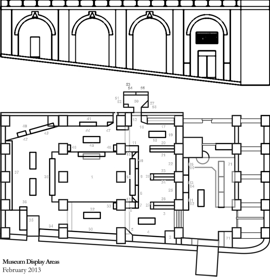Category:Traction engines: Difference between revisions
(Created page with " {{Cars_etc}}") |
m (Text replacement - "{{Cars_etc}}" to "{{RoadVehicle}}") |
||
| (8 intermediate revisions by the same user not shown) | |||
| Line 1: | Line 1: | ||
{{Box|Castor,_quarter_scale_working_model_Fowler_traction_engine_(P_Hains).jpg|1/4-scale Fowler model in the museum lobby|380}} | |||
{{Box|Burrell_traction_engine_model,_GK1962,_Bassett-Lowke,_side_view.jpg|1/16 scale Burrell-type exhibition-grade model based on [[Bassett-Lowke]] castings|380}} | |||
{{Box|Meccano_fairground_traction_engine,_shop_display_model,_yellow.jpg|Meccano retailer's motorised promotional display model of a "Showman's Engine", with sequencing lights|380}} | |||
'''Traction Engines''' were essentially "road steam locomotives", capable of pulling very heavy loads. | |||
'''Agricultural traction engines''' tended to have very heavily-treaded wheels, while engines intended for the road had smoother main drivewheels. The agricultural traction engines were descended from '''ploughing engines''', which could drive to either side of a field in pairs, and then use a steam winch to pull a plough back and forth between them. | |||
{{ | The difficulty with agricultural engines was their size and weight (which could be problematic when using them on soft ground) and for most purposes they were replaced by smaller internal-combustion-engined '''tractors'''. Traction engines also had the advantage (for manufacturers) that a single basic design, with a few parts changes and modifications, could be used to make either a traction engine or a '''[[steamroller]]''', and the early start that British manufacturers had in making these specialist steam vehicles meant that the UK was soon exporting a lot of machines and supplying a significant portion of the world market. | ||
==Showman's Engines== | |||
A niche market for the traction engine was the Showman's Engine, a more ornately-decorated variant popular with travelling funfairs, which coud be used both as a heavy haulage vehicle to help move the fair's equipment between sites, and as a stationary steam engine capable of driving fairground rides directly via a belt drive, or, with the appearance of more electrically-powered rides, driving an electrical generator. | |||
As steam power disappeared from the roads and then also from the railways, the decorative Showman's Engines became nostalgic fairground attractions in their own right, giving people chances to see see and smell a real working steam engine as part of their fairground experience. | |||
==See also:== | |||
* [[:Category: Steamrollers]] | |||
* [[:Category: Steam lorries]] | |||
{{Links}} | |||
* [http://www.ntet.co.uk/ The National Traction Engine Trust (ntet.co.uk)] | |||
* [http://www.steamscenes.org.uk/ Steam Scenes - Traction Engines (steamscenes.org.uk)] | |||
* [http://www.steam-up.co.uk/traction_engine_history.htm A Concise History of the Traction Engine (steam-up.co.uk)] | |||
* [http://www.britishpathe.com/video/traction-engine-doctor Traction Engine Doctor, 1960 (britishpathe.com)] – ''video'' | |||
* [http://www.tractiontalkforum.com/index.php Traction Talk - Traction Engines forum (tractiontalkforum.com)] | |||
* [http://www.tinkerspark.com/steamanddiesel.html Tinker's Park (tinkerspark.com)] | |||
{{RoadVehicle}} | |||
{{SteamRoad}} | |||
Latest revision as of 12:20, 28 January 2022
1/4-scale Fowler model in the museum lobby [image info]
1/16 scale Burrell-type exhibition-grade model based on Bassett-Lowke castings [image info]
Meccano retailer's motorised promotional display model of a "Showman's Engine", with sequencing lights [image info]
Traction Engines were essentially "road steam locomotives", capable of pulling very heavy loads.
Agricultural traction engines tended to have very heavily-treaded wheels, while engines intended for the road had smoother main drivewheels. The agricultural traction engines were descended from ploughing engines, which could drive to either side of a field in pairs, and then use a steam winch to pull a plough back and forth between them.
The difficulty with agricultural engines was their size and weight (which could be problematic when using them on soft ground) and for most purposes they were replaced by smaller internal-combustion-engined tractors. Traction engines also had the advantage (for manufacturers) that a single basic design, with a few parts changes and modifications, could be used to make either a traction engine or a steamroller, and the early start that British manufacturers had in making these specialist steam vehicles meant that the UK was soon exporting a lot of machines and supplying a significant portion of the world market.
Showman's Engines
A niche market for the traction engine was the Showman's Engine, a more ornately-decorated variant popular with travelling funfairs, which coud be used both as a heavy haulage vehicle to help move the fair's equipment between sites, and as a stationary steam engine capable of driving fairground rides directly via a belt drive, or, with the appearance of more electrically-powered rides, driving an electrical generator.
As steam power disappeared from the roads and then also from the railways, the decorative Showman's Engines became nostalgic fairground attractions in their own right, giving people chances to see see and smell a real working steam engine as part of their fairground experience.
See also:
External links
- The National Traction Engine Trust (ntet.co.uk)
- Steam Scenes - Traction Engines (steamscenes.org.uk)
- A Concise History of the Traction Engine (steam-up.co.uk)
- Traction Engine Doctor, 1960 (britishpathe.com) – video
Pages in category ‘Traction engines’
The following 11 pages are in this category, out of 11 total.
F
T
Media in category ‘Traction engines’
The following 41 files are in this category, out of 41 total.
- 1313 Traction Engine TE1a (Mamod 1984).jpg 3,000 × 2,396; 1.24 MB
- 1400 Tractor and Wagon Kit (Mamod 1984).jpg 3,000 × 2,591; 1.24 MB
- Allchin 1925 Traction Engine (Matchbox MYY Y1).jpg 2,000 × 1,495; 1.13 MB
- Allchin 7NHP Traction Engine, Matchbox Y1-1 (MBCat 1959).jpg 1,687 × 1,293; 728 KB
- Bassett-Lowke Burrell-type Traction Engine (MM 1959-11).jpg 1,583 × 1,107; 262 KB
- Bassett-Lowke WW2 advert (MRH12ed 1942).jpg 1,032 × 1,600; 333 KB
- Burrell traction engine model, GK1962, Bassett-Lowke, angle view.jpg 2,600 × 1,661; 1.4 MB
- Burrell traction engine model, GK1962, Bassett-Lowke, detail.jpg 2,000 × 1,334; 1.31 MB
- Burrell traction engine model, GK1962, Bassett-Lowke, side view.jpg 2,200 × 1,425; 1.11 MB
- Burrell Traction Engine, Bassett-Lowke (MM 1954-05).jpg 2,000 × 1,450; 974 KB
- Burrell Traction Engine, HCVS Rally (Brighton 2019-05).jpg 2,232 × 3,000; 1.04 MB
- Burrell traction engine, Streamlinea motor boat, Bassett-Lowke (MM 1935-08).jpg 926 × 1,200; 243 KB
- Burrell-type Traction Engine (BLCat 1962).jpg 1,348 × 2,000; 370 KB
- Castor quarter-scale traction engine nameplate.jpg 1,200 × 919; 463 KB
- Castor, quarter scale working model Fowler traction engine (P Hains).jpg 707 × 1,200; 481 KB
- Foden 1922 Steam Wagon with Traction Engine (Matchbox, Roslyn).jpg 1,024 × 683; 342 KB
- Fowler 1905 B6 Showmans Engine (Matchbox MYY 19-2).jpg 2,000 × 1,304; 437 KB
- Fowler 1924 Showmans Engine (Lesney MYY No9).jpg 1,600 × 964; 254 KB
- Fowler Big Lion Showmans Engine, Matchbox Y9-1 (MBCat 1959).jpg 2,174 × 1,457; 1.27 MB
- Mamod Steam Models. logo.jpg 3,073 × 1,360; 1,005 KB
- Mamod Traction Engine Kit with Trailer, 01.jpg 1,600 × 1,502; 1.25 MB
- Meccano fairground traction engine, shop display model, yellow.jpg 1,200 × 800; 691 KB
- Meccano Magazine, front cover, January 1968 (MM 1968-01).jpg 758 × 1,024; 223 KB
- Meccano Traction Engine (MM 1943-12).jpg 1,502 × 1,049; 393 KB
- Model Railways, Bassett-Lowke Ltd.jpg 901 × 1,339; 267 KB
- Showmans Engine 1380 (Mamod 2006-03).jpg 1,600 × 1,266; 331 KB
- Simply Ageless, Meccano Simplicity models (MM 1968-01).jpg 1,182 × 1,600; 523 KB
- TE1A Traction Engine, front view (Mamod).jpg 1,523 × 2,200; 325 KB
- TE1A Traction Engine, side view (Mamod).jpg 2,200 × 1,587; 378 KB
- Traction Engine and Trailer Kit, assembly diagram (Mamod).jpg 1,547 × 2,200; 817 KB
- Traction Engine and Trailer, Triang Minic (MinicCat 1950).jpg 1,654 × 715; 208 KB
- Traction Engine TE1a 1313 (Mamod 2006-03).jpg 1,600 × 1,446; 343 KB
- Traction Engine, 1in scale (BL-B 1929).jpg 1,640 × 2,500; 746 KB
- Traction Engine, card model (Trix1800 SC5).jpg 1,424 × 1,075; 744 KB
- Traction engine, J and H McLaren, HCVS Rally (Brighton 2019-05).jpg 3,000 × 2,996; 1.38 MB
- Traction Engine, Meccano Display Model 57-14 (MDM 1957).jpg 2,176 × 2,038; 682 KB
- Traction Engine, model 105 (Matador set 1).jpg 2,224 × 1,681; 1.32 MB
- Traction Engine, Model No8 (Nicoltoys Multi-Builder).jpg 1,200 × 549; 102 KB
- Traction engine, postwar (Triang Minic 44M 54M).jpg 1,800 × 1,200; 1.36 MB
- Trailer with Chains, TE1A 1360 (Mamod 2006-03).jpg 1,600 × 1,084; 269 KB














































